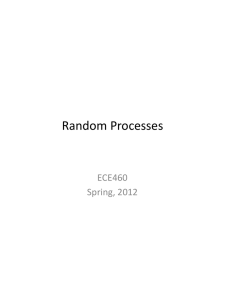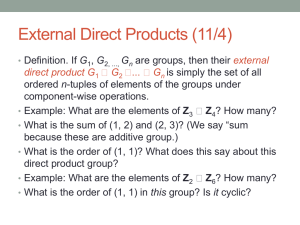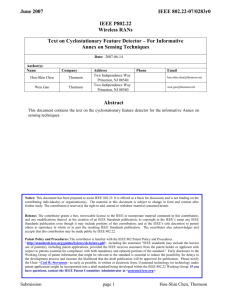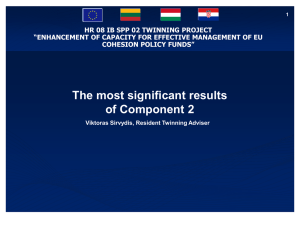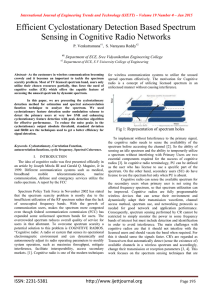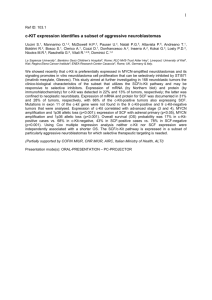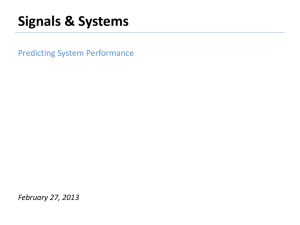Mid Semester Presentation - High Speed Digital Systems Lab
advertisement
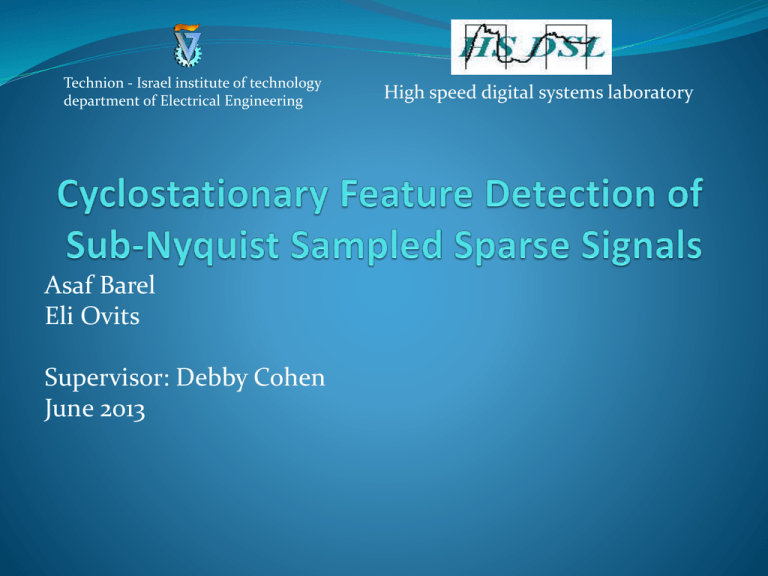
Technion - Israel institute of technology department of Electrical Engineering Asaf Barel Eli Ovits Supervisor: Debby Cohen June 2013 High speed digital systems laboratory Project Motivation Communication Signals are wideband with very high Nyquist rate Communication Signals are Sparse, therefore subnyquist sampling is possible Possible application: Cognitive Radio Current system suffers from low noise robustness Project goal: implementing algorithm for cyclic detection with high noise robustness ~ ~ Background: Sub-Nyquist Sampling MWC system Background: Sub-Nyquist Sampling Digital Processing System Output Full signal reconstruction, or support recovery using Energy Detection The problem: Noise is enhanced by Aliasing Energy Detection: simulation Signal: 𝑁 = 6, 𝐵 = 19.5𝑒6, 𝑡𝑦𝑝𝑒 = 𝑞𝑝𝑠𝑘, 𝑓𝑚𝑎𝑥 = 2.46𝑒9 SNR = 10 dB SNR = -10 dB Original support: Original support: 8 72 90 162 180 244 24 35 117 135 217 228 Reconstructed support: Reconstructed support: 90 180 244 21 200 241 162 72 8 231 52 11 24 87 107 217 232 168 228 165 145 35 20 84 Original support is contained! Original support is not contained! Cyclostationary Signals Wide sense Cyclostationary signal: mean and autocorrelation are periodic with 𝑇0 𝜇𝑥 𝑡 + 𝑇0 = 𝜇𝑥 𝑡 𝑅𝑥 𝑡 + 𝑇0 , 𝜏 = 𝑅𝑥 𝑡, 𝜏 Cyclostationary Signals The Autocorrelation can be expanded in a fourier series: 𝑅𝑥𝛼 𝑅𝑥 𝑡, 𝜏 = 𝛼 𝑅𝑥𝛼 1 𝜏 = 𝑇 𝜏 𝑒 𝑗2𝜋𝛼𝑡 𝑛 ,𝛼 = 𝑇0 ∞ 𝑅𝑥 𝑡, 𝜏 𝑒 −𝑗2𝜋𝛼𝑡 𝑑𝑡 −∞ Cyclostationary Signals Specral Correlation Function (SCF): ∞ 𝑆𝑥𝛼 𝑓 = 𝑅𝑥𝛼 𝜏 𝑒 −𝑗2𝜋𝑓𝜏 𝑑𝜏 −∞ [Gardner, 1994] Cyclostationary Signals The Cyclic Autocorrelation function can also be viewed as cross correlation between frequency modulations of the signal: 𝑅𝑥𝛼 𝜏 = 𝑥 𝑡 𝑒 −𝑗𝜋𝛼𝑡 𝑥 𝑡 − 𝜏 𝑒 𝑗𝜋𝛼 [Gardner, 1994] 𝑡−𝜏 Cyclic Detection Signal Model: Sparse, Cyclostationary signal. No correlation between different bands. The goal: blind detection Support Recovery: instead of simple energy detection, we will use our samples to reconstruct the SCF, and then recover the signal’s support. SCF Reconstruction Using the latter definition for cyclic Autocorrelation, we can get Autocorrelation from a signal: 𝑅𝑥 = 𝑬 𝑥 𝑓 𝑥 𝐻 𝑓 For a Stationary Signal For a Cyclostationary Signal 𝑅𝑥 = 𝑅𝑥 = 𝛼=0 SCF Reconstruction – Mathematical derivation 𝑧 𝑓 = 𝐴𝑥 𝑓 𝑅𝑧 = 𝑬 𝑧 𝑓 𝑧 𝐻 𝑓 = 𝐴𝑅𝑥 𝐴𝐻 𝑟𝑧 = 𝑣𝑒𝑐𝑡𝑜𝑟 𝑅𝑧 𝑟𝑧 = 𝐴∗ ⊗ 𝐴 𝑣𝑒𝑐𝑡𝑜𝑟 𝑅𝑥 Discarding zero elements from 𝑅𝑥 : 𝑟𝑧 = 𝐴∗ ⊗ 𝐴 B 𝑟𝑥 = Φ𝑟𝑥 Algorithm Pseudo Code Pseudo Code Further Objectives MATLAB implementation of the Algorithm Simulation of the new system, including Comparison to the Energy Detection system (Receiver operating characteristic (ROC) in different SNR scenarios ) Comparison to Cyclic detection at Nyquist rate (mean square error ) Gantt Chart 5.6.13 Adaptation of exisiting algorithm to the cyclic case Implementing MATLAB code for SCF reconstruction Adding signal detecion from the SCF Simulations and comparison Optional: Implementing cyclic detection in Hardware simulating enviroument 15.6.13 25.6.13 5.7.13 15.7.13 7 10 10 7 14 25.7.13
